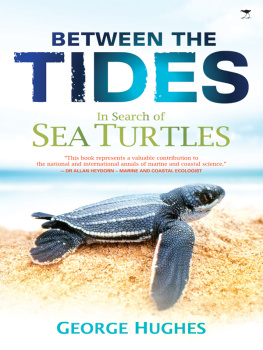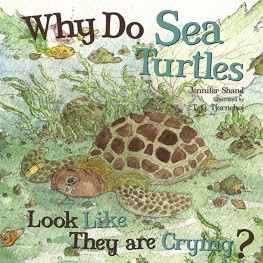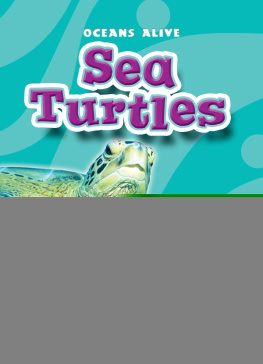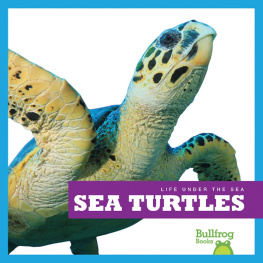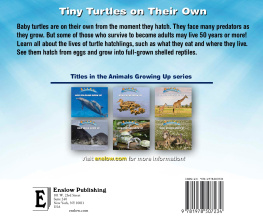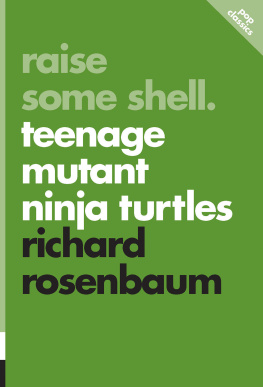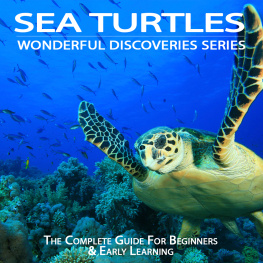A WORLDWIDE TRAVEL GUIDE TO Sea Turtles
MARINE, MARITIME, AND COASTAL BOOKS
SPONSORED BY TEXAS A&M UNIVERSITY AT GALVESTON
WILLIAM MERRELL AND STEPHEN CURLEY, General Editors


A WORLDWIDE TRAVEL GUIDE TO
Sea Turtles
Wallace J. Nichols
Brad Nahill
and
Melissa Gaskill
TEXAS A&M UNIVERSITY PRESS
College Station
Copyright 2014 by
Wallace J. Nichols, Brad Nahill, and Melissa Gaskill
All rights reserved
First edition
Manufactured in China by Everbest Printing Co.
through Four Colour Printing Group
This paper meets the requirements of ANSI/NISO Z39.481992 (Permanence of Paper).
Binding materials have been chosen for durability.

LIBRARY OF CONGRESS CATALOGING-IN-PUBLICATION DATA
Nichols, Wallace J., author.
A worldwide travel guide to sea turtles / Wallace J. Nichols, Brad Nahill, and Melissa Gaskill.First edition.
pages cm. (Marine, maritime, and coastal books)
Includes index.
ISBN 978-1-62349-161-1 (flex : alk. paper)
ISBN 978-1-62349-174-1 (e-book)
1. Sea turtlesConservation.
I. Nahill, Brad, author. II. Gaskill, Melissa, author. III. Title. IV. Series: Marine, maritime, and coastal books.
QL666.C536N53 2014
597.92'8dc23
2013040986
Dedicated to Archie Carr,
who started the sea turtle conservation
movement; to Jairo Mora, who gave his
very life to save sea turtles; and to all the
hardworking, passionate people who walk
beaches every night for very little pay and
lots of hardship. May our children and their
childrens children one day know sea turtles
simply as part of the natural world and
not as endangered species.
If we were logical, the future would be bleak indeed. But we are more than logical. We are human beings, and we have faith, and we have hope, and we can work.
JACQUES COUSTEAU
Contents
THIS is the inaugural volume in a series of Marine, Maritime, and Coastal Books published by Texas A&M University Press and sponsored by Texas A&M University at Galveston.
The sea turtle is at the frontline of conservation efforts for endangered or threatened species, and public opinion plays a key role in helping sea turtle populations recover and remain healthy. A Worldwide Travel Guide to Sea Turtles is an important contribution to their continued existence. Written for both passive armchair enthusiasts and active hip-boot sloggers, it is a readable laypersons turtle-watching guide that balances the rigors of scientific accuracy with the benefits of ecotourism and volunteer vacations.
Stephen Curley and William Merrell
General Editors
Marine, Maritime & Coastal Books
Texas A&M University Press
Preface
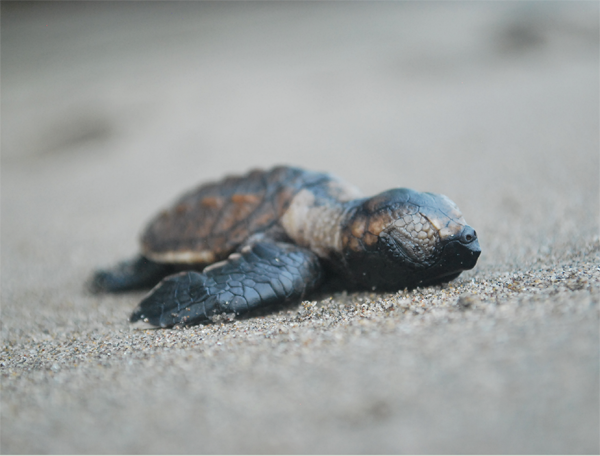
A hawksbill turtle hatchling shortly after emerging from the nest in El Salvador.
(Photo by Brad Nahill/SEEtheWILD)
SEVERAL FEET below the sand, a tiny hatchling struggles out of its round, white egg. A mound of more than 100 other eggs surrounds it. One by one, other baby sea turtles begin to emerge, using a small triangular extension on their beaks to pierce the now-thin eggshells. The collapsing shells create small air spaces, and the tiny turtles thrash about. The flippers of the ones on top of the pile knock down grains of sand, which gradually build up the bottom of the nest, lifting the hatchlings like a rising tide.
Eventually, the hatchlings end up just below the surface of the beach, where they wait for cooler temperatures that signal the coming of night. Then they resume their squirming and thrashing, at last emerging from the sand into the open air. Though they have never seen or smelled the sea, the little turtles instinctively turn toward the open, lighter horizon over the water, away from the dark shadows of dunes behind them. They scramble over ridges of sand, around clumps of seaweed and driftwood, as fast as their little flippers can carry them. Some become a meal for crabs, birds, or other predators along this perilous journey.
Waves breaking on the beach briefly lift the hatchlings, which begin to swim like mad before being dropped back on the sand by the departing water. After a few tries, some succeed in remaining in the waves, which sweep them into the sea. Other predators await beneath the water, catching more of the hatchlings before they can reach the relative safety of floating mats of Sargassum or other shelter. Perhaps one in 1,000 hatchlings will live long enough to reach adult size, when few predators can make a meal of them, and reproduce.
This amazing phenomenon occurs by the thousands around the world, throughout the year. Those who have seen itor the beginning of the process, a mother turtle laying her eggsoften say they will never be the same. They use words like inspiring, transformational, remarkable.
Perhaps you picked up this book because while snorkeling in a clear Caribbean cove, you encountered a sea turtle browsing on seagrass at the bottom. Or you saw juveniles paddling around the end of a fishing jetty or an injured or cold-stunned turtle recovering in a tank at the local aquarium. You may have been fortunate enough to watch a female haul onto a beach to nest or have seen dozens of little hatchlings scurry toward the water to face those almost insurmountable odds of survival to adulthood. Perhaps you have never seen a sea turtle at all and want to join the ranks of those who have been transformed by encounters with these ancient reptiles.
Sea turtles make excellent subjects for ecotravel. These water-dwelling reptiles are charismatic, harmless, photogenic animals that behave in predictable ways. Scientists and locals know when and where they nest and hatch and where you are likely to find them. Done right, with the safety of both sea turtle and traveler in mind, sea turtle watching becomes one of the most memorable experiences we can have with wild nature.
Responsible tourism is also a critical element in worldwide efforts to save these amazing animals (although uncontrolled tourism, ironically, can make things worse). Many sea turtle conservation, monitoring, and research programs rely on tourist visits to help fund their work, to generate local support, and even to keep poachers at bay by their very presence. By visiting and supporting the programs in this book, you can have an unforgettable encounter and will be helping to save sea turtles, their habitat, and the communities around them. Have fun, create lasting memories, and make a difference.
In this guide, we feature destinations dedicated primarily to protecting and preserving turtles and habitat, places that actively encourage visits and involve people in their activities and mission in a responsible fashion. We focus on places that are reasonably accessible and safe and that offer appropriate amenities for a pleasant and educational trip. We do not include those that exploit turtle populations or have a primary focus on tourism, or whose activities and development have negatively affected local populations or habitats.
Next page


